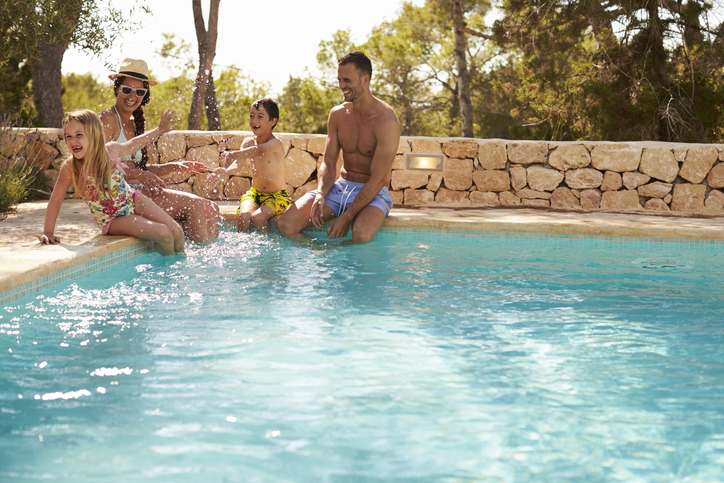Looking for an epic way to spend your summers? Consider adding a swimming pool to your home to create the ultimate staycation, day after day. Nothing says home like sipping a soda poolside as you watch the kids playing a game of Marco Polo or swimming laps for an all-body cardio workout in a refreshing environment. It’s the perfect way to host family get-togethers or parties for your kids’ friends, and we have some advice to help you plan for, build, and maintain a backyard pool.
Along with ensuring fun for kids or a relaxing oasis for adults, building a swimming pool can give a huge boost to the market value of your home. “Does it have a pool?” is a common question that Realtors field from potential home buyers, especially in warmer climates.
Pre-Pool Considerations
Adding a pool to your life (and yard) is an exciting experience. Before you start making pool plans, though, take a good look at your yard. Will a pool enhance your backyard ambiance? Is your yard big enough, and is there adequate access to your backyard for a contractor to dig dirt (and haul it away) and build your pool? Are there trees or a deck in the way that will need to be removed? Do you have existing utility easements, and are wires or pipes running underneath in that location? Will you need to build retaining walls?
These are some of the considerations you’ll need to investigate before you take the leap into pool ownership.
Start Planning Your Pool
As you move from the dreaming to the planning stage, you’ll need to factor in some things, including how much you’ll need to invest in building and maintaining your pool. During the planning process, there’s plenty to do, from deciding what type of pool you want, hiring a contractor, obtaining financing if needed, getting permits, and preparing the location.
Budgeting for a Pool
There are different kinds of pools: above-ground pools and inground pools. The actual cost of your pool will depend on your region and other factors like the size, materials, and features. The average above-ground pool is more economical, and the price also depends on where you live, what materials you use, the size, and other features like an optional deck around the pool.
Factor in Extra Costs
When you’re budgeting, make sure you set aside extra money for electrical work, plumbing, landscaping, fencing and patio improvements. After it’s built, keep extra funds to spend on repairs for your pool pump, lights, and other parts, along with chemicals and professional cleaning.
You may also need to build a fence around your pool. Many cities and counties require a fence for safety reasons.
Before you build a pool, keep in mind that you’ll have monthly fees for pool maintenance and extra electricity to run the pump and other pool components. If you don’t use your pool year-round, don’t forget to factor in the cost of cleaning, preparing for, and safely covering your pool for the winter. These costs will vary depending on the type and size of the pool you build and where you live.
You’ll also want to budget the cost of adding your pool to your existing house insurance policy. Also, ask your agent about liability insurance in case someone is hurt while using your pool.
Where Do you Put Your New Pool?
It’s location, location, location for your new pool. Some people prefer their pool steps away from the back door, while others place their pool a little farther into the yard. The location is up to you, while still considering what’s already in your yard. You’ll want it to blend beautifully with your home and landscape.
Remember, though, that you’ll need to adhere to your local government’s property setbacks for pools and any restrictions if you have a homeowner’s association.
Building your Pool
Now that you’ve decided a pool is in your future, it’s time to rely on your chosen contractor to handle the designing, building, and installation of your pool.
Your contractor will help you decide on the best size, shape, and materials for your pool, whether it’s made from pre-formed fiberglass, or built on-site with vinyl liners or poured concrete. Some homeowners love the convenience and cleaning ease of a smooth fiberglass pool. Fiberglass pools are also a popular choice because they arrive assembled and ready to lower into the hole dug by your contractor’s crew. Or, you may opt for a concrete pool or vinyl liner pool. Above-ground pools are made of steel, aluminum, or resin, with liners. You can also purchase affordable inflatable vinyl above-ground pools that you can set up yourself.
How Long Will it Take?
Swimming pools aren’t built within a weekend. All kinds of variables factor into how long you’ll wait before that first delicious dip into sparkling waters.
Above-ground pools can be installed faster than other types of pools, ready within days. Fiberglass inground pools may take a week or two. Vinyl liner pools may take two weeks to over a month before they’re ready to enjoy. The most expensive pool option, concrete, takes the longest time to complete because construction is more complicated and involves pouring and curing concrete. You may wait months for the project’s completion and your first fun pool party. Other factors, like the weather, can affect the timing of completion.
Pool Decor
While you’re designing your pool, add some color and decorative tiles for a special, relaxing touch. Consider other custom options like underwater lighting, an infinity edge, bench seating or a tanning ledge, ensuring years of personalized enjoyment. Do you plan to swim laps, requiring a longer pool, or prefer weekend relaxing on a water float with a drink in your hand? Consider a shaded lounging area with easy-care pavers, concrete or rubber pool decking.
While your pool’s under construction, pick out lounge seating, landscaping, and outdoor lighting around your pool or even hide those pipes or structures that are not pleasing to the eye in the backyard. Now’s your chance to turn it into your dream oasis. You might also consider installing some type of privacy fencing or shade material to shield your pool from neighbors’ views.
Taking Care of your Swimming Pool
Once your pool is up and running, you’ll need to maintain it regularly. Familiarize yourself with the parts of your pool and how they work. This will help you troubleshoot if something stops working.
Your pool may be basic, or it may have all the bells and whistles like advanced heating and lights or underwater speakers. Your pool may have an automatic pool cover or maybe an above-ground one that the kids spend their weekends in. Either way, all pools share basic components like (of course) water, a filter system, the interior walls or liner, a pool pump, skimmers and returns to circulate the water.
Keep the walls, bottom and/or lining of your pool clean. Those surfaces are always in contact with pool water and can collect debris, algae and mold if not properly cared for.
To keep your pool sparkling clean, you’ll want to buy supplies including a net skimmer, pool brush, and pool vacuum. Use these to help keep bugs, leaves, and other stuff from making your pool unsightly. Residue from shampoos, sunblock, and perfume can also create cleaning issues for your pool.
At least once a week, use the skimmer, brush and vacuum on your pool. Some pool owners find automatic pool cleaners are a huge time-saver. The cleaner patrols your pool whenever you want, brushing the sides and bottom so you don’t have to.
The pool pump keeps your water circulating so your pool doesn’t become polluted and cloudy. Try to run your filter a minimum of 10 to 12 hours a day or more, 7 days a week, according to recommendations from “A Beginner’s Guide to Pool Maintenance”. You’ll also want to backwash your filter regularly, reversing the flow of water so dirty water and contaminants are carried out of your pool.
Chemistry Class
Keeping your pool water clean and balanced is crucial for safe summer fun, according to the Swim University beginner’s guide. Keep a water testing kit nearby so you can tell right away if your pool chemistry is unbalanced, and what to do to bring the water back to sparkling, safe levels.
Your pool’s pH level is important Lower pH levels are considered acidic, and high levels are basic. You should aim for a pH of 7.4 to 7.6. You’ll also need to check the alkalinity, which is a pH buffer so your pool doesn’t have big spikes. Try to keep this between 100 and 150 parts per million, the beginner’s guide advises.
Keep an eye on the level of your chlorine or bromine sanitizer, too. You may need to add chemicals, including an occasional night-time chemical “shock” after rainstorms or heavy pool use. Following directions and safety precautions ensures pool-chemical maintenance success.
Maintenance Schedule
Set up a pool maintenance schedule and stick to it. The more often you regularly skim, clean, backflush, and check chemicals, the more comfortable you’ll become with the routine. Write up a list with dates of the duties and post somewhere that’s easily seen, like on the refrigerator. You can involve the family with the duties, too.
Some homeowners prefer to spend their pool time relaxing so they pay a pool company to maintain the pool chemicals and cleaning schedule.
Enjoying your Swimming Pool
The reward of owning and maintaining a pool is being able to enjoy it whenever you like and the perfect host for all kinds of get-togethers. Your family will cherish this pool for years, and it’s a great incentive for relatives and friends to visit. A pool is the perfect low-impact way to exercise, too, giving a great cardiovascular workout that’s easy on joints and muscles and ensuring less risk of injury.
You can set up a pool basketball hoop or net for hours of fun. Your kids will invent their own pool games, too, under careful supervision of an adult.
Safety First
While a pool brings years of joy, it also comes with the responsibility of making sure swimmers are safe. Make certain your pool meets all fencing and pool signage requirements, and keep a first aid kit nearby. Now is the perfect time to become certified in CPR. In the United States, you can find courses through the American Red Cross, your local YMCA or a swimming organization near you.
Have an adult who knows how to swim watching when kids are in the pool and keep a locking, alarmed fence around your pool when it’s not in use. Parents of smaller children often feel more secure installing alarms on the doors leading to the pool. If you don’t know how to do CPR properly, now is the perfect time to become certified in CPR.
Bring on the Fun
Although the price of building and maintaining a swimming pool can be costly, most homeowners discover that having endless days of laughter and fun under the sun, conveniently right outside their back door, is worth every penny.




